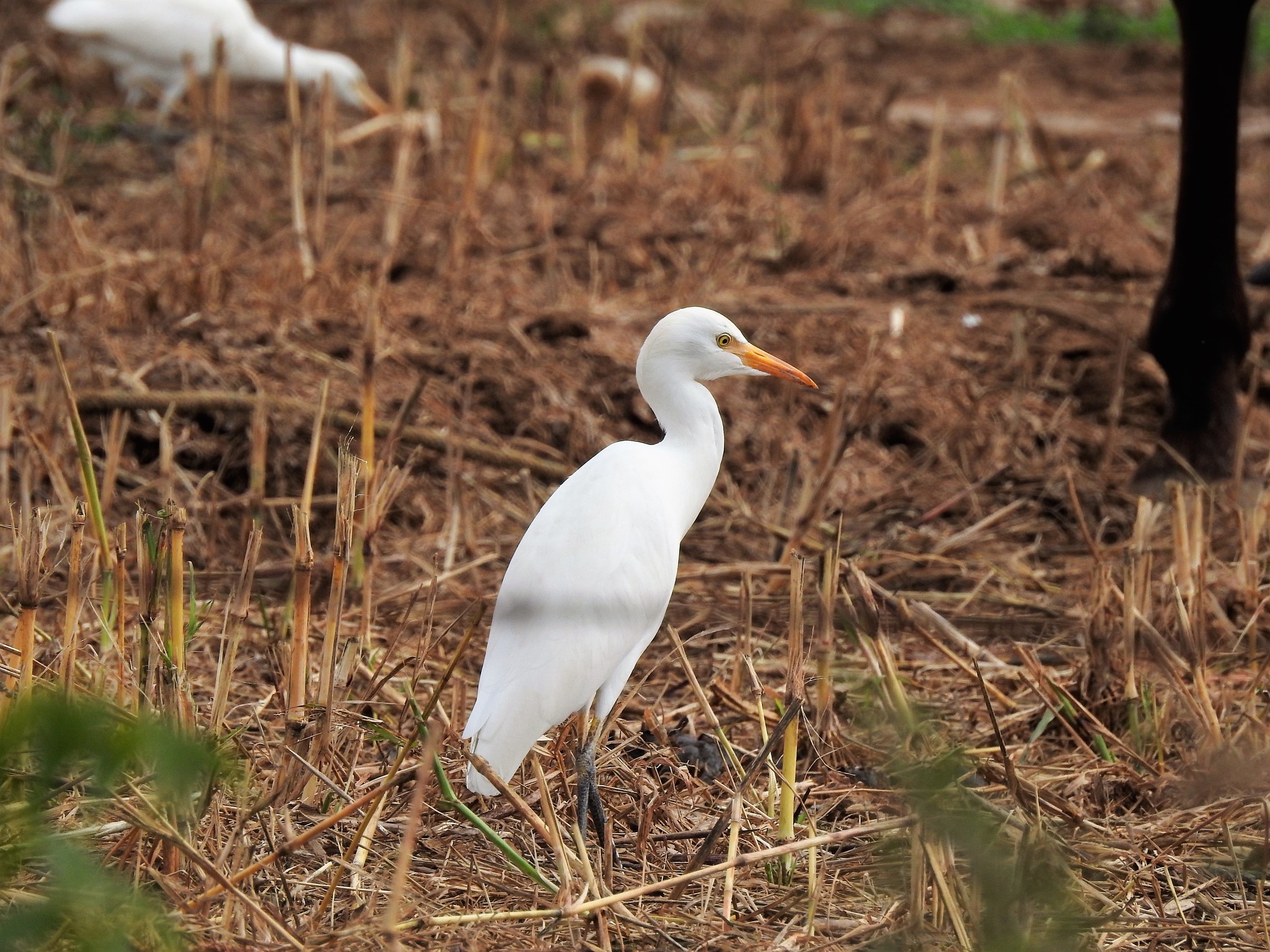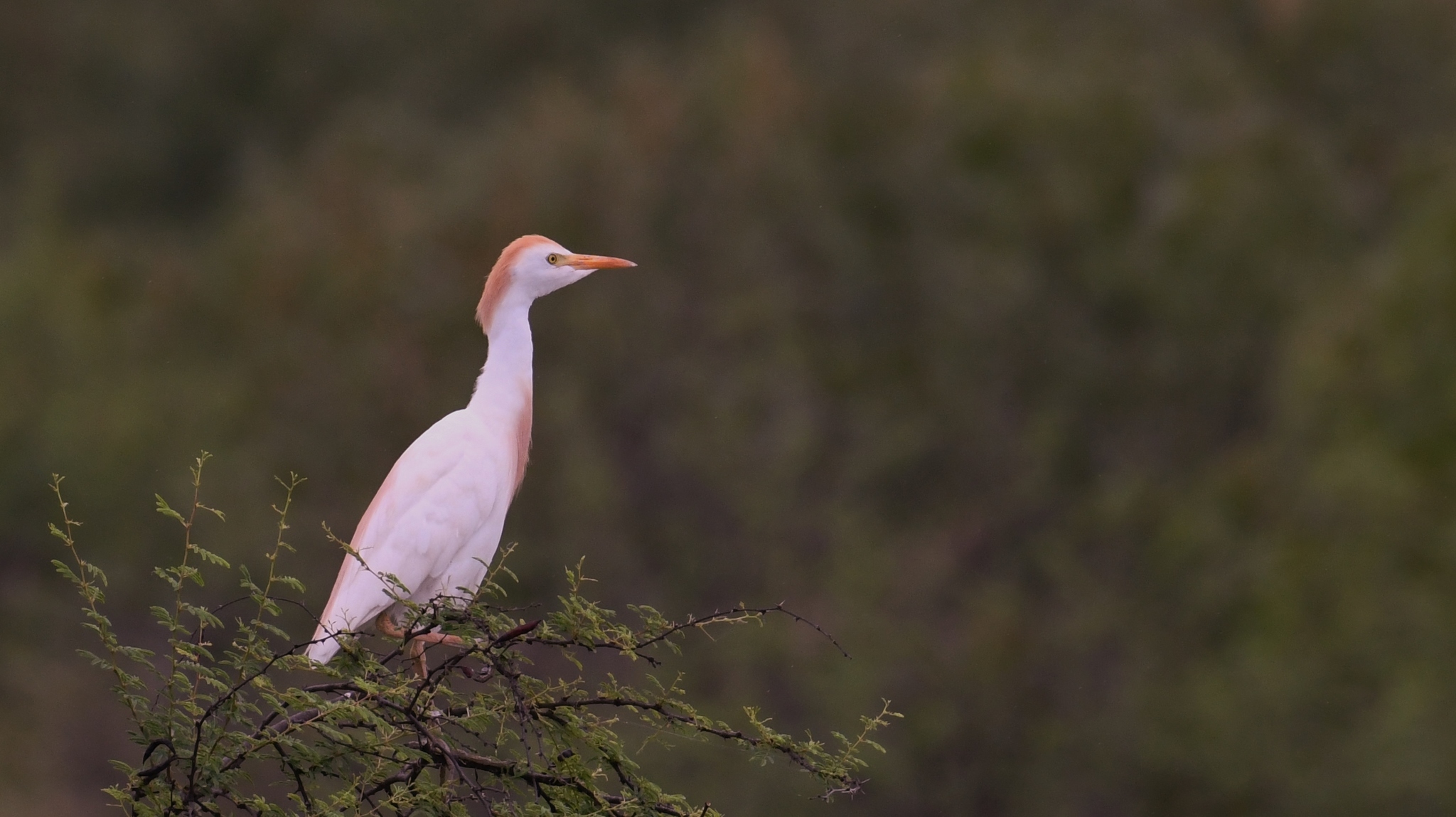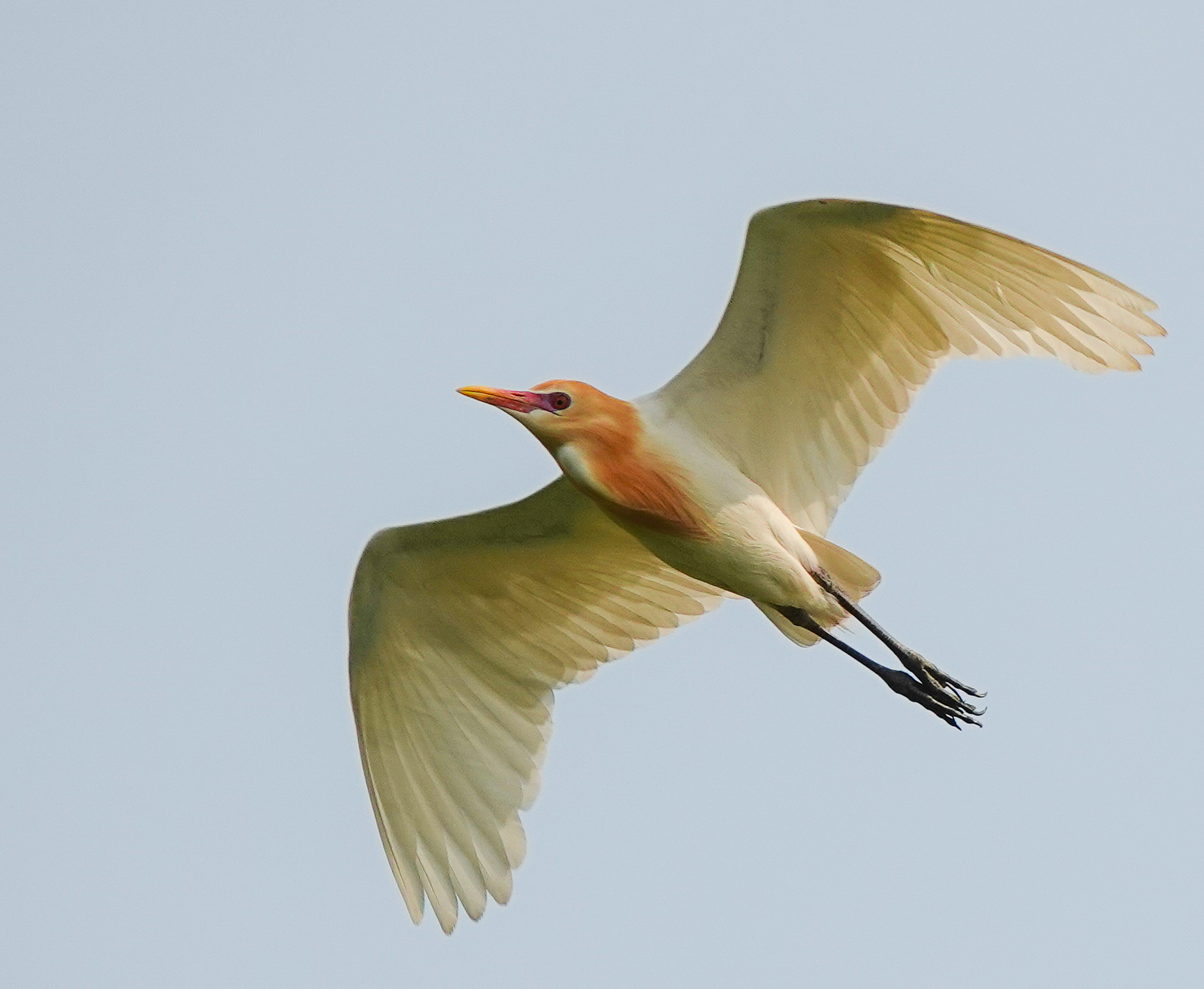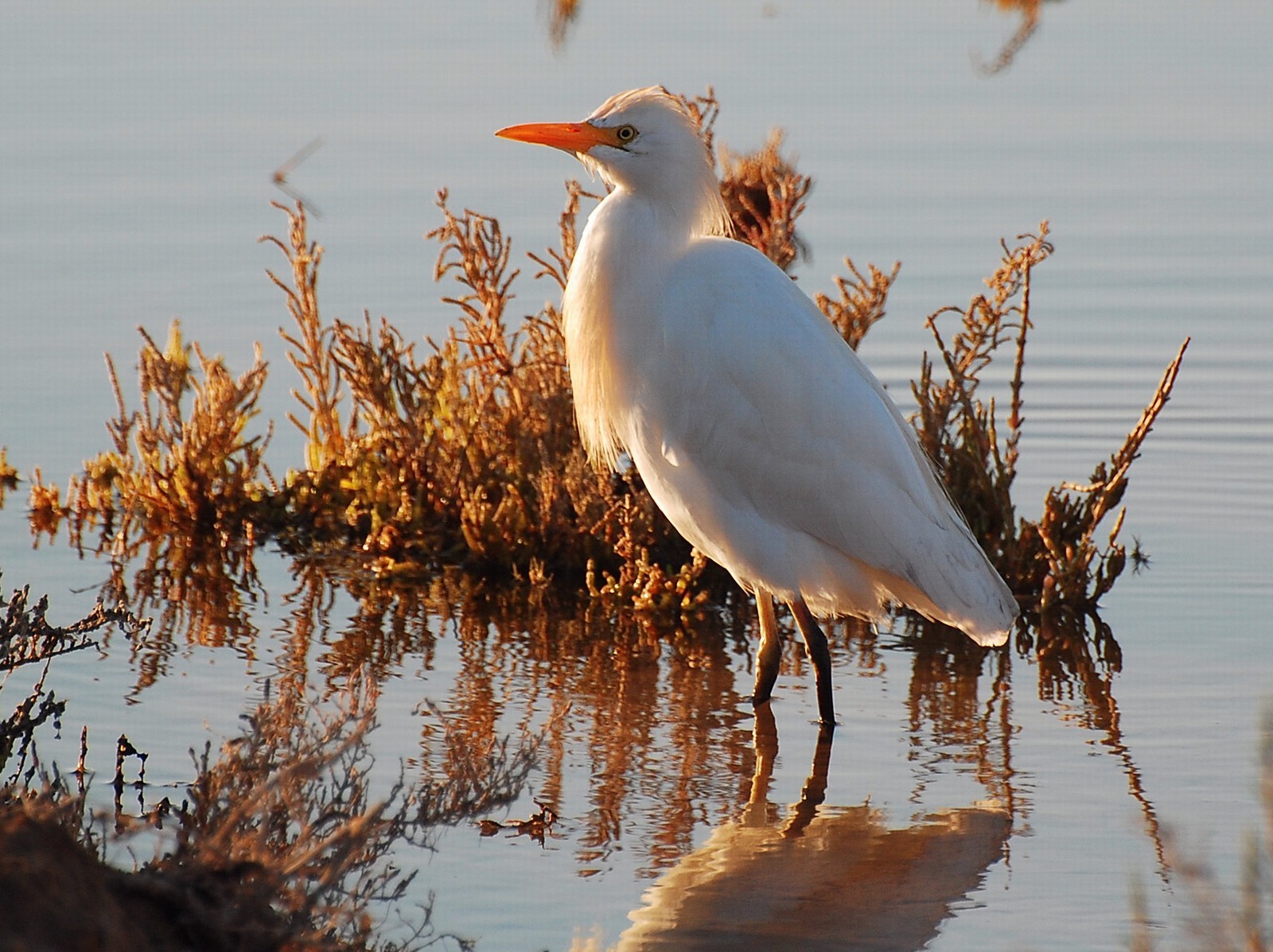- Home
- Conservancy
- Cattle Egret
Description
The cattle egret (Bubulcus ibis) is a cosmopolitan species of heron (family Ardeidae) found in the tropics, subtropics and warm temperate zones. It is the only member of the monotypic genus Bubulcus, although some authorities regard two of its subspecies as full species, the western cattle egret and the eastern cattle egret. Despite the similarities in plumage to the egrets of the genus Egretta, it is more closely related to the herons of Ardea. Originally native to parts of Asia, Africa and Europe, it has undergone a rapid expansion in its distribution and successfully colonised much of the rest of the world in the last century.
It is a white bird adorned with buff plumes in the breeding season. It nests in colonies, usually near bodies of water and often with other wading birds. The nest is a platform of sticks in trees or shrubs. Cattle egrets exploit drier and open habitats more than other heron species. Their feeding habitats include seasonally inundated grasslands, pastures, farmlands, wetlands and rice paddies. They often accompany cattle or other large mammals, catching insect and small vertebrate prey disturbed by these animals. Some populations of the cattle egret are migratory and others show post-breeding dispersal.
The adult cattle egret has few predators, but birds or mammals may raid its nests, and chicks may be lost to starvation, calcium deficiency or disturbance from other large birds. This species maintains a special relationship with cattle, which extends to other large grazing mammals; wider human farming is believed to be a major cause of their suddenly expanded range. The cattle egret removes ticks and flies from cattle and consumes them. This benefits both species, but it has been implicated in the spread of tick-borne animal diseases.
Description
The cattle egret is a stocky heron with an 88–96 cm (35–38 in) wingspan; it is 46–56 cm (18–22 in) long and weighs 270–512 g (9.5–18.1 oz). It has a relatively short thick neck, a sturdy bill, and a hunched posture. The non-breeding adult has mainly white plumage, a yellow bill and greyish-yellow legs. During the breeding season, adults of the nominate western subspecies develop orange-buff plumes on the back, breast and crown, and the bill, legs and irises become bright red for a brief period prior to pairing. The sexes are similar, but the male is marginally larger and has slightly longer breeding plumes than the female; juvenile birds lack coloured plumes and have a black bill.
B. i. coromandus differs from the nominate subspecies in breeding plumage, when the buff colour on its head extends to the cheeks and throat, and the plumes are more golden in colour. This subspecies' bill and tarsus are longer on average than in B. i. ibis.B. i. seychellarum is smaller and shorter-winged than the other forms. It has white cheeks and throat, like B. i. ibis, but the nuptial plumes are golden, as with B. i. coromandus. Individuals with abnormally grey, melanistic plumages have been recorded.
The positioning of the egret's eyes allows for binocular vision during feeding,and physiological studies suggest that the species may be capable of crepuscular or nocturnal activity. Adapted to foraging on land, they have lost the ability possessed by their wetland relatives to accurately correct for light refraction by water.
This species gives a quiet, throaty rick-rack call at the breeding colony, but is otherwise largely silent.
Distribution And Habitat
The cattle egret has undergone one of the most rapid and wide reaching natural expansions of any bird species. It was originally native to parts of Southern Spain and Portugal, tropical and subtropical Africa and humid tropical and subtropical Asia. In the end of the 19th century it began expanding its range into southern Africa, first breeding in the Cape Province in 1908.Cattle egrets were first sighted in the Americas on the boundary of Guiana and Suriname in 1877, having apparently flown across the Atlantic Ocean. It was not until the 1930s that the species is thought to have become established in that area.
The species first arrived in North America in 1941 (these early sightings were originally dismissed as escapees), bred in Florida in 1953, and spread rapidly, breeding for the first time in Canada in 1962. It is now commonly seen as far west as California. It was first recorded breeding in Cuba in 1957, in Costa Rica in 1958, and in Mexico in 1963, although it was probably established before that.In Europe, the species had historically declined in Spain and Portugal, but in the latter part of the 20th century it expanded back through the Iberian Peninsula, and then began to colonise other parts of Europe; southern France in 1958, northern France in 1981 and Italy in 1985. Breeding in the United Kingdom was recorded for the first time in 2008 only a year after an influx seen in the previous year. In 2008, cattle egrets were also reported as having moved into Ireland for the first time. This trend has continued and cattle egrets have become more numerous in southern Britain with influxes in some numbers during the non breeding seasons of 2007/08 and 2016/17. They bred in Britain again in 2017, following an influx in the previous winter, and may become established there.
In Australia, the colonisation began in the 1940s, with the species establishing itself in the north and east of the continent. It began to regularly visit New Zealand in the 1960s. Since 1948 the cattle egret has been permanently resident in Israel. Prior to 1948 it was only a winter visitor. The massive and rapid expansion of the cattle egret's range is due to its relationship with humans and their domesticated animals. Originally adapted to a commensal relationship with large grazing and browsing animals, it was easily able to switch to domesticated cattle and horses. As the keeping of livestock spread throughout the world, the cattle egret was able to occupy otherwise empty niches.Many populations of cattle egrets are highly migratory and dispersive, and this has helped the species' range expansion. The species has been seen as a vagrant in various sub-Antarctic islands, including South Georgia, Marion Island, the South Sandwich Islands and the South Orkney Islands. A small flock of eight birds was also seen in Fiji in 2008.
In addition to the natural expansion of its range, cattle egrets have been deliberately introduced into a few areas. The species was introduced to Hawaii in 1959, and to the Chagos Archipelago in 1955. Successful releases were also made in the Seychelles and Rodrigues, but attempts to introduce the species to Mauritius failed. Numerous birds were also released by Whipsnade Zoo in England, but the species was never established.
Although the cattle egret sometimes feeds in shallow water, unlike most herons it is typically found in fields and dry grassy habitats, reflecting its greater dietary reliance on terrestrial insects rather than aquatic prey
Fun Facts
Feeding
The cattle egret feeds on a wide range of prey, particularly insects, especially grasshoppers, crickets, flies (adults and maggots, and moths, as well as spiders, frogs, and earthworms. In a rare instance they have been observed foraging along the branches of a banyan tree for ripe figs.The species is usually found with cattle and other large grazing and browsing animals, and catches small creatures disturbed by the mammals. Studies have shown that cattle egret foraging success is much higher when foraging near a large animal than when feeding singly. When foraging with cattle, it has been shown to be 3.6 times more successful in capturing prey than when foraging alone. Its performance is similar when it follows farm machinery, but it is forced to move more. In urban situations cattle egrets have also been observed foraging in peculiar situations such as railway lines.
A cattle egret will weakly defend the area around a grazing animal against others of the same species, but if the area is swamped by egrets, it will give up and continue foraging elsewhere. Where numerous large animals are present, cattle egrets selectively forage around species that move at around 5–15 steps per minute, avoiding faster and slower moving herds; in Africa, cattle egrets selectively forage behind plains zebras, waterbuck, blue wildebeest and Cape buffalo.Dominant birds feed nearest to the host, and thus obtain more food.
The cattle egret sometimes shows versatility in its diet. On islands with seabird colonies, it will prey on the eggs and chicks of terns and other seabirds. During migration It has also been reported to eat exhausted migrating landbirds. Birds of the Seychelles race also indulge in some kleptoparasitism, chasing the chicks of sooty terns and forcing them to disgorge food





